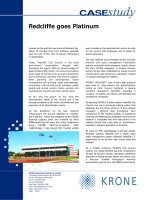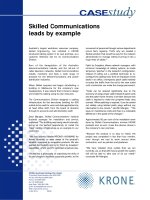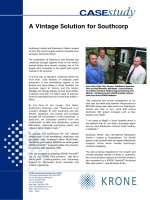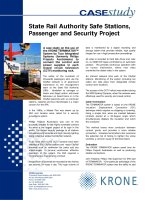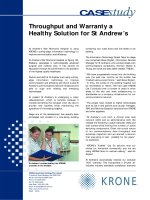Tài liệu Case study - CopperTen - Syncroness chose ADC KRONE pptx
Bạn đang xem bản rút gọn của tài liệu. Xem và tải ngay bản đầy đủ của tài liệu tại đây (140.96 KB, 4 trang )
Designing leading-edge products with lead-
ing-edge tools; there is hardly a more precise
statement to illustrate why Syncroness has
emerged as a global player in new product
development. It also explains why the firm
chose ADC to provide high-performance
cabling infrastructure for its new corporate
headquarters in Westminster, Colorado.
“Our business is totally dependant upon our number one tool – computer
power,” said Jörg Lorsheider, Syncroness’ director of business development and
sales. “Our network has to be operational at peak proficiency 100 percent of
the time and that means it needs to work quickly. When we considered the
available choices for high-performance Ethernet cabling, we found that ADC’s
new CopperTen system has capabilities far beyond anything else on the market.”
COLOSSAL FILES REQUIRE ENORMOUS CAPABILITIES
Syncroness employs more than 30 mechanical engineers who use the most-
advanced computer-aided design (CAD) software to invent or improve a wide
variety of products; from golf clubs to exercise machines, medical devices to
products used in space exploration. With offices in Irvine, California and Kuala
SYNCRONESS CHOOSES ADC’S REVOLUTIONARY COPPERTEN
™
10-GIGABIT ETHERNET UTP CABLING FOR NEW HEADQUARTERS
CASE STUDY
Lumpur, Malaysia, Syncroness engineers
create and share immense amounts of data
among themselves and their clients around
the world.
“We operate a variety of different CAD
systems that require us to transfer multi-
megabit files all over the place,” said
Lorscheider. “In fact, we generate 25 gigs
of new or revised data each week and,
for a business of this size, that’s a lot of
data. That’s more than a lot of big com-
panies generate.”
Syncroness also utilizes complex simulation
software to perform fluid dynamics compu-
tations and structural and thermal analyses
on products. These processes rely on dis-
tributed computing to combine the
resources of several separate processors
while consuming large amounts of band-
width in order to solve problems. “We
share information over tens of thousands of
miles – between the United States and
Malaysia. We certainly don’t want to create
a bottleneck here in our own office.”
Syncroness evaluated optical fiber in its
quest to provide the “biggest pipe” for its network. 10-gigabit Ethernet performance was manda-
tory, yet the cost of fiber optics proved prohibitive. “With fiber, the expense is in the electronics,”
said David Yanish, of ADC’s global product management group. “It’s necessary to invest in com-
plex hardware that converts electrical data into photons (light) in order to send the information
over fiber optic cable, then additional hardware to reconvert that information back into electrons
at the other end. That makes fiber about six times more expensive than unshielded twisted pair
(UTP) cable. So, with a 10-gigabit standard on the horizon, we went to work developing a com-
pletely new copper solution - CopperTen.”
10 GIGABITS AND BEYOND
For years, the industry predicted a shift
toward a fiber-based cabling structure within
buildings. But, as the need for a 10G Base-T
standard emerged, ADC‘s KRONE develop-
ment team invested in breakthrough design
and manufacturing technologies, creating
CopperTen, a complete end-to-end cabling
system that delivers a solution more cost-
effective and easier to install than shielded
CASE STUDY
CASE STUDY
and fiber optic cabling systems.
CopperTen is the industry’s first aug-
mented Category 6 UTP cabling system
and it is guaranteed to enable 10-giga-
bit transmission to be implemented to
the full 100 meters required for struc-
tured cabling systems. “In fact, we can
guarantee 18 gigabits per second of
channel capacity, and right now, no
one else can do that,” said Yanish.
“Cat 6 was supposed to be the next
solution. While it did produce more
bandwidth, or pipe size, it couldn’t
support 10-gig Ethernet. CopperTen
does; it provides a ten-fold increase in
the transmission of large amounts of data as measured by Shannon’s Capacity*, while extending
bandwidth to enable a capacity greater than 18 gigabits per second up to 625 MHz. And CopperTen
does all this while eliminating alien crosstalk.”
Alien crosstalk is signal noise generated from adjacent cables. It has plagued high-capacity copper
cable designs for years. ADC combats alien crosstalk with its patent-pending oblique elliptical star
filler, which never allows bordering conductors to touch or get too close to one another. This design,
combined with the company’s unique cable manufacturing process, oscillate the cable pairs off-cen-
ter, isolating each connector from the other.
“These components and designs working in unison result in remarkable advantages that put
CopperTen in a league by itself, representing the next generation of cabling technology.”
AN INVESTMENT IN TODAY – AND TOMORROW
CopperTen re-establishes copper as the better-
priced solution for “future-proofing” Local Area
Networks for the next protocols. This first-of-a-kind
product allows a confident reach to the next level
of transmission performance.
“As standards are changing, we have to stay cur-
rent and competitive,” said Lorsheider. “We have
to be ready for the future by investing in the best
products for our infrastructure, such as CopperTen.
We get paid by the hour, and the more work we
can produce during that hour, the more value our
customers receive while we remain competitive. We
expect this network system to last and are pleased
we won’t have to rewire in five years.”
ADC Telecommunications, Inc., P.O. Box 1101, Minneapolis, Minnesota USA 55440-1101
Specifications published here are current as of the date of publication of this document. Because we are continuously
improving our products, ADC reserves the right to change specifications without prior notice. At any time, you
may verify product specifications by contacting our headquarters office in Minneapolis. ADC Telecommunications,
Inc. views its patent portfolio as an important corporate asset and vigorously enforces its patents. Products or
features contained herein may be covered by one or more U.S. or foreign patents. An Equal Opportunity Employer
1309749 11/04 Original © 2004 ADC Telecommunications, Inc. All Rights Reserved
Web Site: www.adc.com
From North America, Call Toll Free: 1-800-366-3891 • Outside of North America: +1-952-938-8080
Fax: +1-952-917-3237 • For a listing of ADC’s global sales office locations, please refer to our web site.
CASE STUDY
SYNCHRONICITY
Like all business success stories, this one celebrates relationships between partners who recognize
the important role each plays in reaching their individual goals. When it was time to name their
corporation, the five owners of Syncroness chose a name that promoted their formula for success-
ful relationships. Says Lorsheider, “The name describes our ability to “synchronize” our capabilities
and talents with the needs of our customers; to harmonize our bases of knowledge. That is the
relationship we form with our customers and the kind of relationship ADC has formed with us.”
ABOUT ADC
ADC completed its acquisition of the KRONE Group on May 18, 2004. ADC is a world leader in
providing global network infrastructure products, services and software that enable the profitable
delivery of high-speed Internet, data, video, and voice services over our customers’ unique net-
works. ADC (NASDAQ: ADCT) has sales into more than 90 countries. KRONE has served the indus-
try as the leading manufacturer and supplier of fiber cabling, interconnection and distribution
devices used in copper and fiber optic telecommunications and data networks. More information
on KRONE is available at www.krone.com. Lean more about ADC Telecommunications, Inc. at
www.adc.com.
*Shannon’s Capacity formula is: Q = B log2 (1+S) concerning a communications channel: the formula that relates
bandwidth in Hertz, to information carrying capacity in bits per second. Where Q is the information carrying capacity
(ICC), B is the bandwidth and S is the signal-to-noise ratio. This expression shows that the ICC is proportional to the
bandwidth, but is not identical to it.




